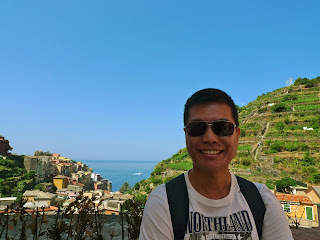How time flies, it's once again time to celebrate the wifey's birthday. As usual, she'll have some place in mind that she'd like to try out. This year we're off to Babette, a restaurant/ bar situated at Parc Sovereign Hotel, along Tyrwhitt Road. Although marketed as a "restro-bar", you wouldn't find anyone outside at the counter in this sweltering heat. The first thing I noticed is the lack of a dress code. Decked out in my polo-tee, jeans and brown leather shoes, I felt somewhat overdressed. The other guys were in berms and (*Gasp!) flip-flops.
Babette draws its inspiration from the 1980s film "Babette's Feast", which is about how a good chef can transform a dinner into a love affair. It is precisely this reason that the wifey chose this place. For starters we had the sous vide Octopus Tempura. One would think that using the sous vide method would make it more tender. However, this was not the case. The batter tasted simple and "home-made" and not in the positive sense, not something that you'd expect from a good restaurant.
 |
| Top marks for presentation. Not so for taste. |
Next came the Grilled Asparagus in garlic miso cream. I wasn't expecting much from this dish and honestly, it didn't look like much. A surprise was in store. The asparagus was cooked just right, not too crunchy and not too soggy. The miso cream was of the right consistency. It made the asparagus that much smoother. The deep fried ginger garnish was also an excellent complement. It's tanginess contrasted nicely with the milky-sweetness of the cream, bringing out the best in the asparagus.
 |
| Worth a try. |
The starters ended with the arrival of the Crackling Pork Belly. Now this is something to shout about. The dish arrived with thick chunky slices. The 48 hours of slow cooking had really done its job. Pop one piece into your mouth and the first thing you'll encounter is the crunching of the crispy skin. This is followed by the sinking of your teeth into tender meat, as the fat melts away almost simultaneously. For those who cannot take food that is too spicy, the accompanying whole-grain mustard sauce is for you. Slather a generous helping on your meat and experience how it brings out the flavour.
 |
| Crackling Pork Belly and Babette Chirashi Donburi - both looking equally enticing but oh so different in giving satisfaction. |
We chose the Babette Chirash Donburi for main. It looked promising enough but turned out to be a bitter disappointment. Firstly, the ingredients were not cold enough. Instead of complementing the sashimi, the warm rice prevented us from assessing it's freshness. This resulted in a dish that is neither refreshingly cool nor pippingly appetizing. Who serves warm rice in chirashi don anyway? Some people may enjoy the contrast of hard crunchy pickles against the soft squishiness of sashimi but not I. Besides, the pickles could've been more sour. It was almost akin to eating raw carrots. I would also prefer tuna roe to tobiko any day. Verdict: don't bother trying this dish. All looks and no substance.
In the end, although we were quite full, we decided to give Babette a chance at redemption. The signature Macha Lava Cake took 20mins to prepare. Frankly it didn't feel very long because I was in good company. First impression, it held a lot of promise.

As the restaurant would describe it: this is a "green tea infused white chocolate fondant served with home-made azuki red bean ice-cream". Slice into the "cake" and dark green "white" chocolate oozes out. The cloying sweetness almost stung my tongue, as I savoured the sticky goodness of the green tea infused chocolate. With each spoonful of green gooey goodness, I edged closer to the precipice of "over sweetness". Just when I thought I would fall over, a wave of refreshing coolness swept me backwards, as I relished the taste of home-made ice-cream on my palate. Not wanting to lose the sweetness that I just discovered, I delved again into the green softness. This time, the bite of mint brought me back. A spoonful of ice-cream now tasted a tad bland. This was immediately resolved by the intrusion of azuki reds.

To wash it all down, we had a tall glass of yuzu beer. To conclude, Babette is not a place for important celebrations. However, I wouldn't mind chilling out here. Food-wise, there are hits and misses. I probably won't be back too quickly. Maybe I'll try their other offerings in the future.



















































